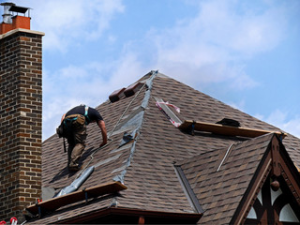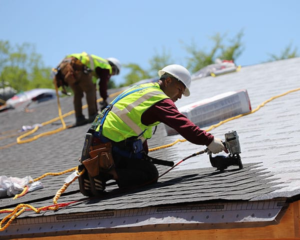Home » Articles posted by Krystal Brewer (Page 2)
Author Archives: Krystal Brewer
Choosing the Right Roofing Materials for Your Home
Your roof takes a beating from rain, snow, sleet, hail, harsh sun and wind. Choosing the right materials and having a well-constructed roof that can endure for years is an important home improvement investment.
Slate is a heavy material that requires special framing to support it. Its chemical and mineral makeup also lend it distinctive hues that can shift with weathering. Contact Cambridge Roofing now!

Slate is a beautiful roofing option that can add a lot of curb appeal to your home. The stone-like tiles are available in a variety of shapes, sizes, and colors. They can be used to create a traditional roof, but they are also popular with modern architectural styles. Slate is more expensive than other roofing materials, but it can last for up to a century. It is best installed by a professional roofer who has experience with this type of roofing.
Slate can be very fragile, so it is important to handle it correctly when working on the roof. A mistake can cause damage that could result in costly repairs. It is also more difficult to install than other types of roofing. It can be more difficult to find roofers who know how to work with slate, so you may have to pay a higher price for specialized service.
The installation process can be time-consuming, and the materials must be carefully cut to size before they are installed. The roof must be properly inspected before installing the slate, and it is important to ensure that the proper head lap is provided. For example, a slate that is not covered by the two rows above it can allow water to seep into the roof. In addition, the slate must be securely fastened to the roof with copper nails.
Slate roofs are built in a standard course layout, with each row being set against the one before it. When laying the slates it is essential to have the correct amount of overlap, which is determined by the pitch or angle of the roof. This can be determined by using a special app that is designed for this purpose.
The roof can be capped with a ridge cap, which is often made from copper or another non-corrosive metal. This is an important part of the roof because it helps to keep the structure protected from the elements. The roof must be inspected to make sure that the cap is secure, and it is also necessary to have a proper gutter system in place. This will prevent water from leaking into the home. Slate roofs are also known for their insulation properties, which can lead to a lower energy bill. However, this is only possible if the homeowner practices energy-efficient habits to begin with.
As their name suggests, clay tiles are made from a clay base. The clay is kneaded, dried, and then fired in a kiln to make it hard enough for roofing. The firing process transforms the raw, gray, moist clay into an array of orange, red, yellow, and cream tones. The coloration of the clay is an integral part of its charm and beauty as a roof material.
Aside from their aesthetic appeal and the aesthetically pleasing appearance they add to homes, clay tile roofs have a very durable and long lifespan. If properly maintained, a clay tile roof can last over a century. This is because they are very wind resistant and can withstand high winds without shifting or moving. Additionally, clay tiles are impervious to hail.
While they offer a wide range of benefits and advantages, they also tend to be quite expensive as compared to other roofing materials. They are more difficult to install as well since they require a lot of special tools and expertise to handle correctly. Nevertheless, they are very effective in terms of energy efficiency. The curved design of clay tiles moves hot air away from your home during the summer, and they are also very effective at keeping cold air in during the winter, thus decreasing your energy bills considerably.
Another significant benefit of clay tiles is their ecological sustainability. They are a completely natural product and they do not create harmful emissions during their manufacturing process. Furthermore, they do not require a lot of chemicals to make them sturdy and can be recycled easily when they are no longer needed.
As you can imagine, all these features and benefits of clay tiles add up to a very effective and reliable roof material that will not only increase your home’s value but also help you save on your electricity bills. However, they can be quite fragile when walked on, and you have to be very careful. This is why it is best to hire a professional roofer for installing clay tiles. Also, they are quite heavy so they will require a stronger and sturdier structure to support them.
Wood is a classic choice for residential roofs and can enhance your home’s aesthetic. However, it is prone to moisture and requires more maintenance than other roofing materials. Wood can also be a fire hazard, so it’s not recommended for homes in wildfire-prone areas. Wood shakes and shingles are available in several different styles and can add to your home’s value.
Shake roofs are a type of wood roofing that is split on one side, giving it more texture than traditional shingles. The split surface allows for additional water resistance and can reduce the overall weight of your roof. Wood shakes can be made from many different types of wood, including cedar, cypress, and redwood. They are available in a variety of thicknesses and colors.
There are two main types of wood shakes: slash grain and edge grain. Slash grain shakes are cut at an angle to the tree’s rings and are more likely to distort over time. Edge grain shakes are cut perpendicular to the rings, providing more stability and a longer life expectancy.
Although stains and paints can protect wood from water damage, the material does still absorb moisture. This can cause it to swell, warp, or crack over time, exposing your home to leaks and mold. Wood is also susceptible to insects like termites and wood borers, so it’s important to choose an insect-resistant type of wood for your roof.
While some homeowners may love the rustic look of a weathered wood roof, others prefer a clean and more modern look. While wood is an eco-friendly option if it’s sustainably harvested, it can be expensive to maintain and is more flammable than other roofing options. Wood can be treated with fire-retardant chemicals, but this isn’t guaranteed to prevent it from burning in the event of a fire. In addition, wood is prone to rot and mold, so it’s important to maintain it regularly.
Asphalt shingles are the most popular roofing material in the country, found on 4 out of 5 new homes. They are easy to install and come in a wide range of colors, styles, and price options. There are some drawbacks, however, to this type of roof, especially in regards to the environment. During production, asphalt shingles use petroleum byproducts and coal tar. This creates a dark and oily substance that, if exposed to water, can leak into your home.
To help protect your home from this issue, an underlayment must be placed over the bare roof deck before applying the asphalt shingles. This performs two critical functions: it provides temporary weather protection until the shingles are installed, and it acts as an additional protective barrier should moisture infiltrate the shingles themselves.
Most roofing contractors use a breathable underlayment such as felt paper or brown tar shingle, which prevents the penetration of water and air into the roof deck, while also providing a surface for the installation of the asphalt shingles. Upon installing the underlayment, the roofing contractor will apply a thin layer of hot tar over the sheathing felt. This process requires a high level of skill, and experienced roofing professionals always use heat-resistant gloves and special roofing shoes to ensure their safety.
The asphalt shingles are then layered over the underlayment. They are typically topped with ceramic-coated mineral granules, which provide the color and offer resistance to fire and the sun’s UV rays. The granules are also designed to help the shingles resist mold and algae growth.
In addition to their beauty, granules also help the shingles stay cooler, which can be an advantage for homeowners in warmer climates. Some manufacturers are also producing energy-efficient asphalt shingles, which reflect the sun’s rays rather than absorb them.
Because of their affordability and durability, asphalt shingles are the most popular roofing material. They are available in a variety of styles and designs to match the aesthetics of almost any home, from classic three-tab shingles to architectural dimensional shingles. Some shingles even mimic the look of other roofing materials like slate and cedar shakes.


